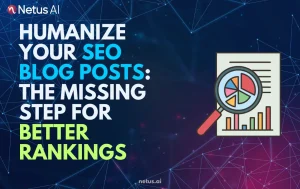
Why Google’s ‘Who, How, Why’ Framework Matters for EEAT | NetusAI
Why Google’s ‘Who, How, Why’ Framework Matters for EEAT AI can create articles in seconds. But here’s the truth: speed is not enough. Google wants
Global Plagiarism: Uncovering the Alarming Trend in Academic and Professional Fields

Content writer and editor for Netus.AI
Global Plagiarism. Plagiarism, the unethical act of using someone else’s work without proper credit, is a form of theft in the world of content creation. Writers often get confused between the concepts of plagiarism and inspiration. While inspiration involves deriving ideas from another author’s work and filtering them through one’s own perspective, plagiarism occurs when a writer copies content directly or merely substitutes words with synonyms while keeping the structure and ideas intact.
The world of entertainment and literature often witnesses new creations inspired by existing ones. For instance, without Flintstones, there would have been no Simpsons, and without Scooby-Doo, shows like Buffy the Vampire Slayer and Cabin in the Woods may never have come to life. However, it is crucial for writers to maintain the delicate balance between drawing inspiration from others’ works and plagiarism. Crossing this line can severely damage a writer’s credibility and ethical integrity.
Global plagiarism refers to the act of copying an entire work by another author and claiming it as one’s own without giving due credit to the original creator. It is considered a serious form of plagiarism, as it is typically done intentionally by students or writers. This type of plagiarism is particularly damaging within academia and academic settings, as it undermines the integrity of education and research. To avoid global plagiarism, it is crucial for individuals to always attribute their sources and use proper citations when referencing other works.
Theorists worldwide are exploring how music can impact a person’s health. Ongoing studies are looking into the healing abilities of music in various contexts. For example, some research suggests that music can provide relief for schizophrenia patients. Music has acquired a reputation for alleviating depression and anxiety through the use of specific wavelengths that produce a calming atmosphere. Consequently, certain types of music are recognized as inherently comforting.
Theorists worldwide are exploring how music can impact a person’s health. Ongoing studies are looking into the healing abilities of music in various contexts. For example, some research suggests that music can provide relief for schizophrenia patients. Music has acquired a reputation for alleviating depression and anxiety through the use of specific wavelengths that produce a calming atmosphere. Consequently, certain types of music are recognized as inherently comforting.
Credibility Damage: Bloggers and content creators might be tempted to produce more content to attract a larger audience. However, using plagiarized material could lead to a loss of credibility, driving away potential customers and readers.
SEO Ranking Issues: Search engines like Google aim to provide users with quality search results by removing websites containing duplicate content. Thus, plagiarized content can drastically reduce organic traffic and negatively affect a business’s online performance.
Academic Integrity: Educational institutions take plagiarism seriously as it can undermine academic integrity. Students might think that using plagiarized materials in their papers will increase their grades, but this belief is misguided.
Consequences for Students: Students who are caught submitting plagiarized content, whether provided by essay writing services or copied directly, can face severe repercussions. Since global plagiarism is intentional, consequences can include failing grades, suspension, and even expulsion.
Remember to always cite your sources to avoid intellectual property theft and other plagiarism-related consequences.
Yes, global plagiarism can be detected using specialized tools like Turnitin. These plagiarism checkers can effectively spot word-for-word copying. However, when spinning tools are employed to manipulate the text, it becomes more challenging for these checkers to identify the copied content.
It is essential to note that experienced readers can often recognize plagiarism from inconsistencies in writing style. Here’s a summary of how detection works:
Remember, avoiding global plagiarism maintains academic integrity and fosters originality in research and writing.
There are several methods in which students might engage in global plagiarism, varying in severity and intention. Instances may include:
Addressing these varying forms of plagiarism, students should strive to adhere to ethical practices in academic writing, acknowledging original authorship and maintaining honesty in their research and ideas.
To prevent global plagiarism, students should focus on composing their work independently, instead of simply copying the entire content from another author. Utilizing reference materials as a guide is essential, but the key lies in understanding and interpreting them to reflect their own knowledge and analysis.
In cases where it is necessary to use parts of another author’s work to support an argument, there are steps to follow to avoid plagiarism:
Practicing these methods consistently is a crucial aspect of maintaining academic integrity and originality. By ensuring proper citation and giving credit to the original author, students can avoid global plagiarism while demonstrating their comprehension and ability to develop unique arguments.
To ensure originality in your work or a received document from writing services, employ a global plagiarism checker tool. This instrument analyzes and compares texts with existing content to detect any similarities. It identifies duplicate passages and provides a detailed report, including the plagiarism percentage.
Using plagiarism checkers enables students to quickly recognize and address instances of global plagiarism. The tools offer a confident, knowledgeable, neutral, and clear understanding of your content’s originality.
Global plagiarism can be identified by examining the originality of the entire work. If a significant portion or the whole text appears to be copied from another source or authored by someone else, it can be considered global plagiarism. Plagiarism detection tools can also be effective in recognizing such instances of plagiarism.
Self-plagiarism refers to using one’s own previously published work in a new publication without proper citation or permission, while global plagiarism involves submitting an entire work created by someone else as one’s own. The key difference lies in the fact that self-plagiarism involves copying one’s own work, while global plagiarism involves copying someone else’s work.
Global plagiarism is considered a severe ethical violation because it undermines the principles of academic honesty, originality, and intellectual property. By presenting someone else’s work as one’s own, an individual is committing a form of academic dishonesty and stealing the intellectual property of the original author.
Global plagiarism diminishes the integrity of academic work by presenting a false representation of the author’s knowledge, skills, and contributions. When a student or researcher plagiarizes, they jeopardize their reputation, academic standing, and the trust of their peers, which can lead to long-lasting consequences in the academic and professional realms.
Incremental plagiarism occurs when a writer uses multiple sources and selectively copies sentences or phrases, combining them to create a new work that appears original. In contrast, global plagiarism happens when an entire work is copied from another source and passed off as the writer’s own. Incremental plagiarism usually involves smaller portions of text, while global plagiarism involves the entire piece.
Yes, plagiarism detection tools are designed to detect instances of global plagiarism by comparing the submitted work to a database of sources, including published articles, books, and online resources. These tools have varying degrees of effectiveness, depending on factors such as the size of the database, the sophistication of the algorithm, and the thoroughness of the comparison. However, they generally provide a reliable means of identifying global plagiarism in written work.

Why Google’s ‘Who, How, Why’ Framework Matters for EEAT AI can create articles in seconds. But here’s the truth: speed is not enough. Google wants

SEO Writer’s Guide to Google’s Helpful Content Update Keeping up with Google’s algorithm changes can feel like a relentless game of whack-a-mole. Just when you

Can AI Content Be Safe for SEO in 2025? Let’s start with the question of keeping every content strategist, SEO pro and blogger awake at

Humanize Your SEO Blog Posts: The Missing Step for Better Rankings You’ve done everything by the book. Your keyword research is impeccable. Your meta descriptions

How to Pass AI Detection Tests as an SEO Writer Let’s paint a familiar picture. You’ve just finished a blog post. The headline is sharp,

Why Your AI SEO Blog Isn’t Ranking (And How to Fix It) You embraced AI for your blog. The promise was intoxicating: high-quality content, published
@ 2024 Netus AI.